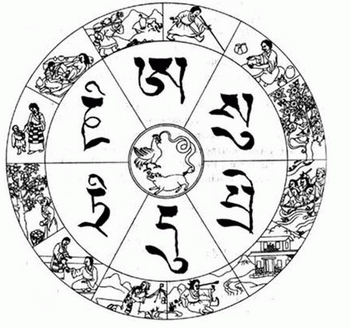THE FIVE SKANDHAS by Chogyam
Trungpa To understand more precisely the
process of confirming the solidity of I and other, that is,
the development of ego, it is helpful to be familiar with
the five skandhas, a set of Buddhist concepts which describe
ego a five-step process. The first step or skandha, the birth
of ego, is called “form” or basic ignorance. We ignore the
open, fluid, and intelligent quality of space. When a gap or space occurs in our
experience of mind, when there is a sudden glimpse of
awareness openness, absence of self, then a suspicion arise:
“Suppose I find that there is no solid me? That possibility
scares me. I don’t want to go into that. That abstract
paranoia, the discomfort that something may be wrong, is the
source of karmic chain reactions. It is the fear of ultimate
confusion and despair. The fear of the absence of the self,
of the egoless state, is a constant threat to us. “Suppose
it is true, what then? I am afraid to look.” We want to
maintain some solidity but the only material available with
which to work is space, the absence of ego, so we try to
solidify or freeze that experience of space. Ignorance in
this case is not stupidity, but it is a kind of
stubbornness. Suddenly we are bewildered by the discovery of
selflessness and do not want to accept it; we want to hold
on to something. Then the next step is the attempt to
find a way of occupying ourselves, diverting our attention
from our aloneness. The karmic chain reaction begins. Karma
is dependent upon the relativity of this and that–my
existence and my projections–and karma is continually
reborn as we continually try to busy ourselves. In other
words, there is a fear of not being confirmed by our
projections. One must constantly try to prove that one does
exist by feeling one’s projections as a solid thing. Feeling
the solidity of something seemingly outside you reassures
you that you are a solid entity as well. This is the second
skandha, “feeling.” In the third stage, ego develops
three strategies or impulses with which to relate to its
projections: indifference, passion and aggression. These
impulses are guided by perception. Perception, in this case,
is the self-conscious feeling that you must officially
report back to central headquarters what is happening in any
given moment. Then you can manipulate each situation by
organizing another strategy. In the strategy of indifference, we
numb any sensitive areas that we want to avoid, that we
think might hurt us. We put on a suit of armor. The second
strategy is passion–trying to grasp things and eat them up.
It is a magnetizing process. Usually we do not grasp if we
feel rich enough. But whenever there is a feeling of
poverty, hunger, impotence, then we reach out, we extend our
tentacles and attempt to hold onto something. Aggression,
the third strategy, is also based on the experience of
poverty, the feeling that you cannot survive and therefore
must ward off anything that threatens your property or food.
Moreover, the more aware you are of the possibilities of
being threatened, the more desperate your reaction becomes.
You try to run faster and faster in order to find a way of
feeding or defending yourself. This speeding about is a form
of aggression. Aggression, passion, indifference are part of
the third skandha, “perception/impulse.” Ignorance, feeling, impulse and
perception–all are instinctive processes. We operate a
radar system which senses our territory. Yet we cannot
establish ego properly without intellect, without the
ability to conceptualize and name. Since we have so many
things happening, we begin to categorize them, putting them
into certain pigeon-holes, naming them. We make it official,
so to speak. So “intellect” or “concept” is the next stage
of ego, the fourth skandha, but even this is not quite
enough. We need a very active and efficient mechanism to
keep the instinctive and intellectual processes of ego
coordinated. That is the last development of ego, the fifth
skandha, “consciousness.” Consciousness consists of emotions
and irregular thought patterns, all of which taken together
form the different fantasy worlds with which we occupy
ourselves. These fantasy worlds are referred to in the
scriptures as the “six realms”. The emotions are the
highlights of ego, the generals of ego’s army; subconscious
thought, day-dreams and other thoughts connect one highlight
to another. So thoughts form ego’s army and are constantly
in motion, constantly busy. Our thoughts are neurotic in the
sense that they irregular, changing direction all the time
and overlapping one another. We continually jump from one
thought to the next, from spiritual thoughts to sexual
fantasies to money matters to domestic thoughts and so on.
The whole development of the five skandhas–ignorance/form,
feeling, impulse/perception, concept and consciousness–is
an attempt on our part to shield ourselves from the truth of
our insubstantiality. The practice of meditation is to see
the transparency of this shield. But we cannot immediately
start dealing with the basic ignorance itself; that would be
like trying to push a wall down all at once. If we want to
take this wall down, we must take it down brick by brick; we
start with immediately available material, a stepping stone.
So the practice of meditation starts with the emotions and
thoughts, particularly with the thought process.
See more on Chogyam Trungpa Rinpoche
from the first issue of the Garuda
magazine published in
1971.
When Avalokiteshvara, deeply
examining the perfection of wisdom, Avalokiteshvara, “the one who
looks compassionately down on all beings,” considered
the perfection of how to become wise, and saw the five
skandhas, A skandha is a “pile” or a
“heap” or a “collection”. (It’s
normally translated “aggregate”, which is a bunch
of stuff formed into a “collection, mass, or
amount”.) In the open space of infinite
compassion, through ignorance (form) the five skandhas
develope: First in the the physical
forms—for example, a bell. Out of form (basic ignorance)
Connection to the form by a physical sense – so, the
reception of the sound of the ringing bell by the ear – ego
– identification with the physical body and brain (conscious
and unconsious). The connection of the physical
sensation with a mental perception—“you” hear
the sound of the “bell”. Then identification of a
mental perception…”I hear that bell” – and so meaning
reveberates. Reinforcing the sense of there being a
“you” (ego) which “hears the bell” and
thus the ego is set in motion, into being and manifesting
…pile(s), divisions and the twelve chains of
causation. Twelve
nidanas or twelve-linked chain of dependent
origination. An early
doctrine of Buddhism showing the causal relationship between
ignorance, the skandas, and suffering.
Lankavatara
Sutra

Adi Da
Samraj
Also see: The
Six States of Bardo
